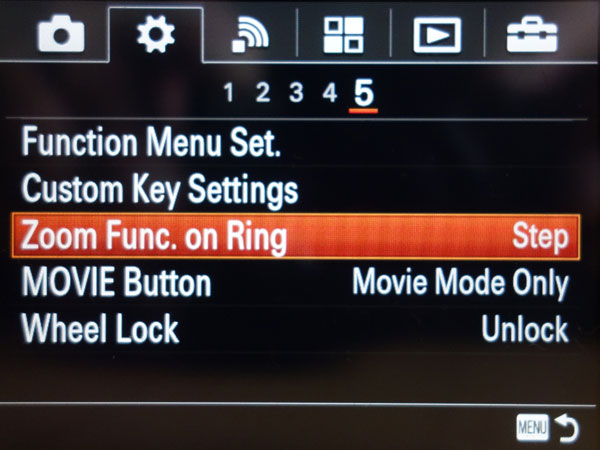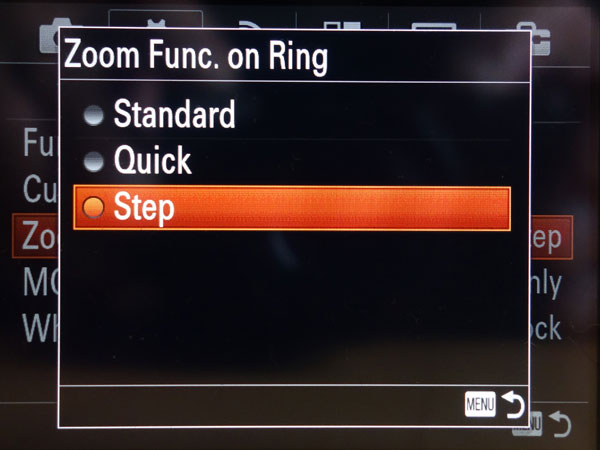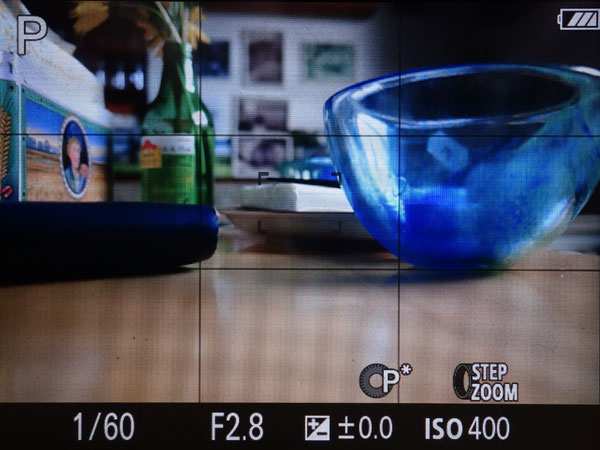Sony RX100 M4: Configuration
Introduction: Overview of What Can Be Configured | The Configuration Options in Detail | How I Use the Configuration Options | Further Useful Settings | Conclusions | Links and Books | Appendix: A Demonstration of the Settings Screens
On this page, I describe how you can configure the Sony RX100 M4. I demonstrate the basic configuration options for this camera, but I cannot guarantee that my list of configuration options is complete... I also describe my configuration choices.
Also note that there are further settings that are only listed described here; some of them will be described elsewhere (for example, support for manual focusing).
Note: I got somewhat crazy about how to write the Sony terminology. Books and manuals differ in many ways. I will write names (on buttons, in menus, etc.) in upper case and italic (or example: the Focus Tracking function, in short, Focus Tracking) and most other things in lower case (even though Sony writes "Control Ring" - but control wheel...). Please note that I am not a native speaker and that there will be many errors...
Introduction: Overview of What Can Be Configured (or Configures the Camera...)
In the following, I will describe the options that the Sony RX100 M4 offers for configuration. Configuration means in this case that you can configure certain camera controls (dials, levers, buttons) to behave in different ways, for example, to allow you to set different things (for example, to set exposure, focus, or dynamic range).
Buttons that set variants or modes of a certain function will, on the other hand, not be regarded as configurable here (for example, the flash button that cycles through different flash modes). But some entities may be "borderline cases"...
Note that I might also have chosen to simply list all the menus and their options, but then I would have just replicated the camera manual.
Overview of the RX100 M4 Controls
 |
Top view (from left to right to bottom)
|
|
 |
Rear view (from top to bottom)
|
|
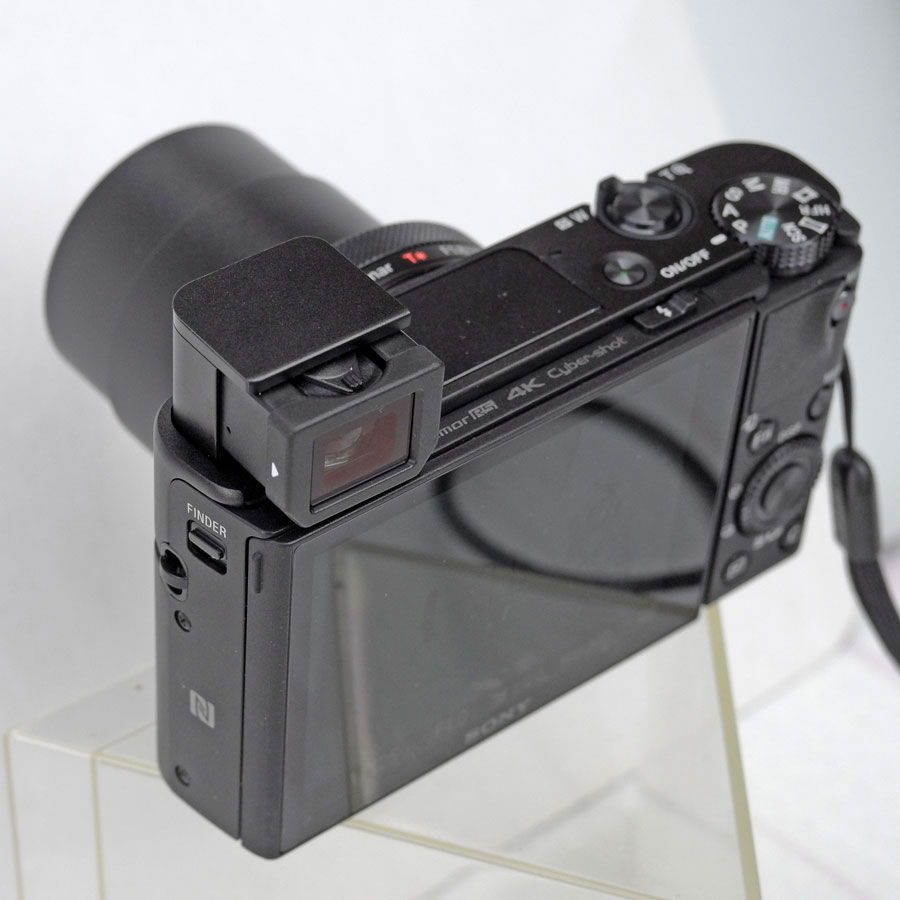 |
Side/rear view Pop-up viewfinder and release button for the viewfinder at the side (close to the top) |
(C) Configurable (more or less...); the former Help/Delete button (? symbol) is now also configurable (in contrast to the RX100 M1) and therefore called Custom button (C symbol).
The Configuration Options in Detail
| Control | Sub-Control | Text/Symbols | Options | Default | My Settings |
| Control Ring | Standard: Performs one function that is specific to the selected shooting mode (e.g. P: program shift, A: aperture, S: shutter speed) Can be set in the Custom menu, Custom Key Settings > Control Ring to one of the following functions:
The following options always have priority:
|
Standard | Zoom (Step Zoom) | ||
| Fn Button |
|
Fn | Offers twelve slots (in two rows), which can be assigned in the Custom menu, Function Menu Set. to one of the following functions:
Review: Image rotation |
1: Drive Mode |
1: Drive Mode |
| Control Wheel | Top button | DISP | In the Custom menu DISP Button you can define, which screen types are shown (in cyclic order). There are two options, Monitor and Finder:
|
unknown | Monitor: Display All Info., No Displ. Info., Histogram, Level,
For Viewfinder Finder: Display All Info., No Displ. Info., Histogram, Level |
| Left button | Self-timer, Drive Mode | Can be assigned in the Custom menu, Custom Key Settings > Left Button to one of the following functions:
|
Self-timer, Drive Mode | AF/MF Control Toggle* | |
| Right button | Flash (Mode) | Can be assigned in the Custom menu, Custom Key Settings > Right Button to one of the following functions:
|
Flash Mode | AEL toggle* | |
| Bottom button | Exposure Compensation, Creativity Style | Depends on the selected mode:
|
Depends on the selected mode | Exposure Compensation | |
| Center button | SET (no text) | Can be assigned in the Custom menu, Custom Key Settings > Center Button to one of the following functions:
In the Standard setting, the center button activates focus tracking - or the movement of the flexible spot if this focus mode is activated. If the focus magnifier is active, the center button toggles between magnifications. Also used to set (confirm) values. |
Standard | Standard | |
| Wheel | Used to select values by turning the control wheel clockwise or counter-clockwise. | n.a. | n.a. | ||
| Custom/Delete Button | C | Too many options to be listed here (50 options or "Not set")... | In-Camera Guide | Focus Magnifier** |
*) I put the original functions into the Fn menu. **) Works only if MF is selected (directly or via AF/MF toggle).
Note that many of the controls perform additional tasks such as moving the AF area, switching between functions, etc. Moreover, half-pressing the shutter button cancels playback and magnifications modes and exits menus and help screens.
In the table above, I also list my current configuration, but do not take that information too seriously. My assignments may change over time and according to my changing needs and habits - and I may forget to update our assignments here...
How I Use the Configuration Options
On this page, I more or less describe the "mechanics" of the configuration options for the Sony RX100 M4. For ways of using them, I would like to point you to some books where this topic is dealt with (see links below).
Nevertheless, I tried to use the configuration options so that I can achieve certain functionalities more easily. I describe this in the following. On page Sony RX100 M1: Custom Settings, I describe several ways how you can configure the camera controls. I do not want to repeat this here, and instead will only present my current solution and possible variants. On the RX100 M4, there is one more configurable button available, namely the C (custom) button. This seemingly small difference makes indeed things a lot easier on this camera, compared with the RX100 M1.
Overview of the Configuration
On the RX100 M4, I use the left and right buttons for the AF and AE lock functions, whereby the AF/MF Control Toggle function "simulates" an AF lock and at the same time also toggles between AF and MF. The center button remains in the Standard setting, which enables focus tracking (AF Area set to Center or Wide) or moving the flexible AF spot (AF Area set to Flexible Spot or Expand Flexible Spot). The custom button is also configurable on this camera and can be used for activating the Focus Magnifier function, as I currently do. This is not possible on the RX100 M1. All this leads to the following assignments:
- Left: AF/MF Control Toggle (AE lock and AF/MF toggle)*
- Right: AEL toggle (AE lock)*
- Center: Standard (AF Area = Center or Wide: Focus Tracking; AF Area = [Expand] Flexible Spot: Movable and sizeable AF spot)
- Custom: Focus Magnifier**
- Fn: See below
- Control Ring: Zoom (Step Zoom)
Notes
- I assigned the overwritten default functions of the control wheel buttons (Self-timer/Drive Mode and Flash Mode) to positions in the Fn menu (see table above).
- **) Works only if MF is selected (directly or via AF/MF toggle).
Configuration of the Custom Keys
The so-called Custom Keys are: the Control Ring , C(ustom) Button, Center Button, Left Button, and Right Button. The Custom Key Settings are done in the Custom menu on page 5:
In the following, I describe the settings for the custom keys, except for the control ring, which is dealt with further below.
AEL (Automatic Exposure Lock, Right Button)
Implementing an easy access to AE lock is simple because there is already such a function available, namely AEL toggle. You simply have to assign it to a configurable button. In my case, I assigned this function to the right button of the control wheel.
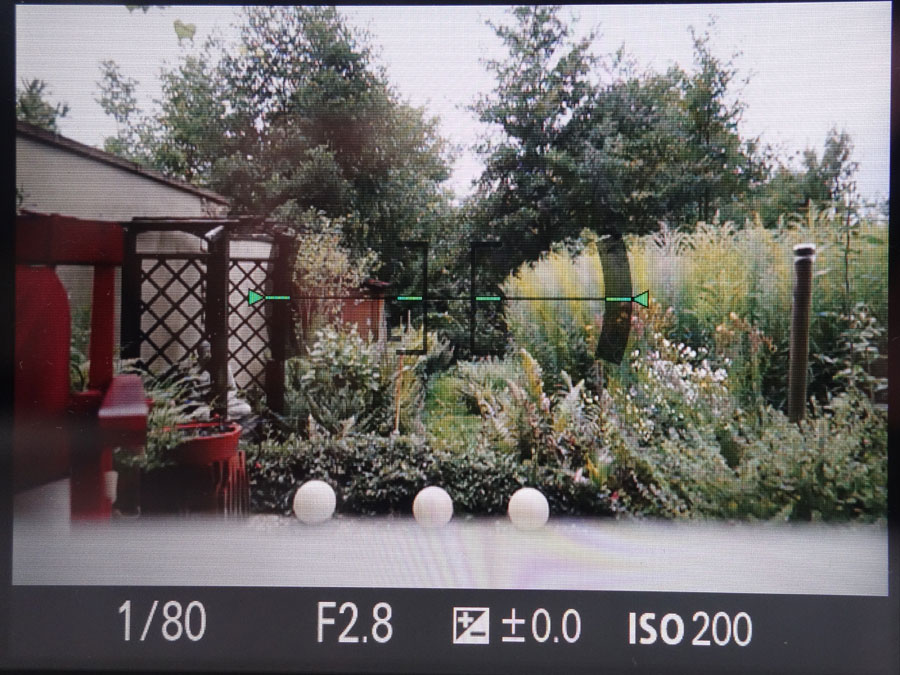 |
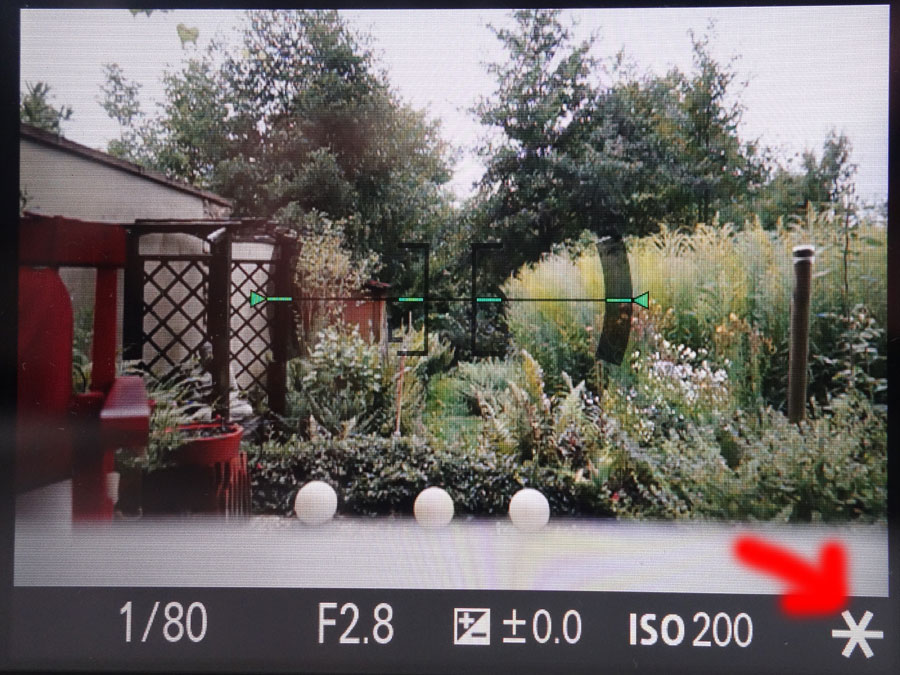 |
Figures: AE lock is indicated at the bottom right of the screen by an asterisk (right); I use it as a toggle function (left: AE lock not activated).
AFL (Autofocus Lock, Left Button)
AF lock, however, is not directly available as a function, and you need a work-around to simulate this functionality. In the end, this work-around is even more powerful than a simple AFL function. The work-around is provided by the AF/MF Control Toggle function, which does what its name says. The important trick, however, is that when you switch from AF to MF, the camera sets MF to the distance (or focus) that AF had set before. Thus, if you toggle from AF to MF you effectively lock the focus - as long as you do not change the focus manually. The latter might even be an option if you think that the focus needs some improvement (for example, if you are not quite sure, whether AF really set the focus to infinity see below). That's why I wrote that the work-around is even more powerful than a simple AFL function.
All you need to make the AF/MF Control Toggle function easily accessible, is to assign it to another configurable button - I use the left button of the control wheel for this purpose. Of course, you can reverse the arrangement (that is, exchange the functions that you assigned to the left and right buttons).
By the way, on the RX100 M4 it is possible to set the distance to infinity thanks to the distance scale that briefly appears on the screen, when you focus manually (that is, when you turn the control ring). Particular for infinity, you no longer need to point the camera to a distant object as is necessary with the RX100 M1, because it is at the end of the scale. And if you are unsure about which direction to turn the control ring, the distance scale will also tell you whether you are right or wrong...
Note: I assigned the overwritten default function of the control wheel button (Self-timer/Drive Mode) to positions in the Fn menu (see table above).
Focus Magnifier (Custom Button)
I found out that it is best, to assign the Focus Magnifier function* to the custom button so that the center button can be used for the purposes described below. Use the center button to run through the magnifications, but note that this ends the magnification after a you reached a magnification of 17 x (in contrast to the RX100 M1, which cycles through the magnifications).
Notes
- I assigned the overwritten default function of the control wheel button (Flash Mode) to a position in the Fn menu (see table above).
- *) Works only if MF is selected (directly or via AF/MF toggle).
Center Button on Standard: Support for the Flexible Spot or for Focus Tracking
If you set the center button to Standard, the behavior of this button can depend on some other camera settings, for example, of the Autofocus Area setting. I found the following two further assignments quite useful:
- Flexible Spot: Set the Autofocus Area to Flexible Spot in order to be able to move the autofocus spot area and use the center button to enter end leave the state, in which you can move the flexible spot. This works well for me when shooting close-ups and macros using AF on the M1 (on the M4, this issue can be avoided, because there is one more button that can be customized).
- Focus Tracking: Set the Autofocus Area to Multi or Center and use the center button to initiate Focus Tracking. As I found out, this can also be useful for close-up shots when you want to use AF and alleviate somewhat the movements of the target or your own movements. See page Close-Ups with Focus Tracking for more information on this topic.
Note: At the moment, I usually use the assignments with Autofocus Area set to Center, so that the center button activates the default function of Focus Tracking. Whenever I want to use the flexible spot, I set the Autofocus Area to Flexible Spot.
Configuration of the Fn Button
The Fn button offers twelve slots (in two rows), each of which can be assigned in the Custom menu, Function Menu Set. to one of 34 functions plus Not set. That is, you can not only assign these functions to the 12 slots, but you can also determine the positions of the functions. This can be handy in case that you often change the same functions (for example, ISO and DRO/HDR). If you place them to nearby slots, changing their attributes is easier as if you place them at opposite ends of the two-row table.
The following screens demonstrate how functions are assigned to the slots of the Fn button menu:
 |
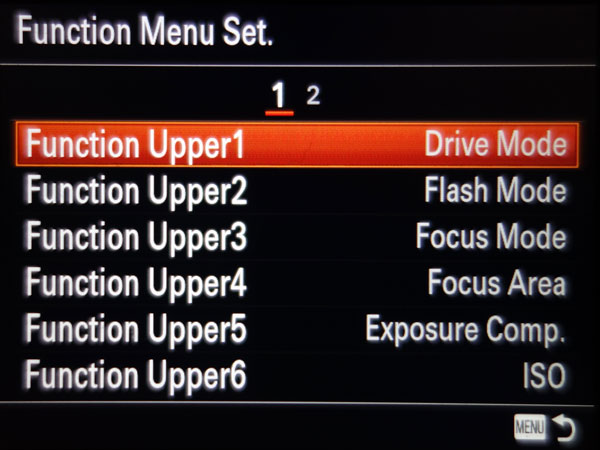 |
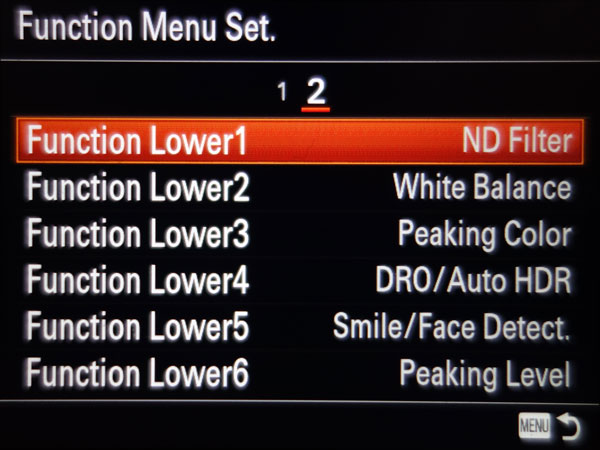 |
||
The Function Menu Set. menu item in the Custom menu (page 5) allows you to assign 12 function to the Fn menu slots. |
The assignment is done on two pages, one for the upper slots... |
... and one for the lower slots. |
||
 |
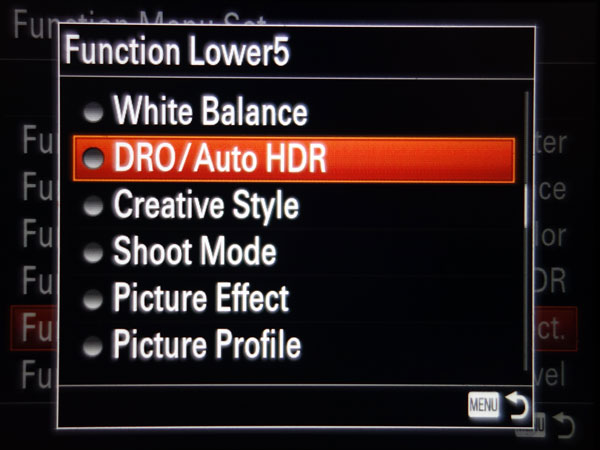 |
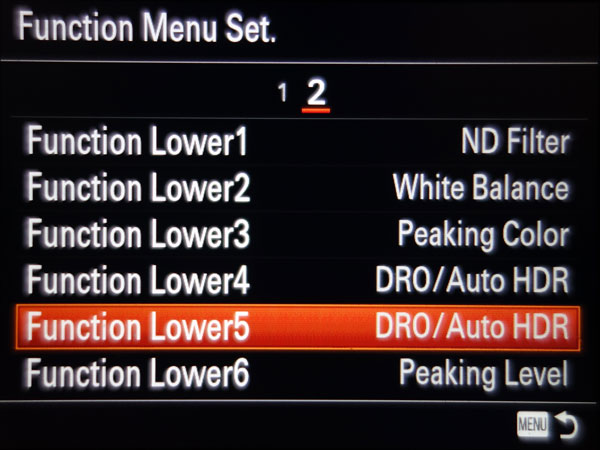 |
||
Since I do not need the Smile/Face Detect. function... |
... I assign the DRO/Auto HDR function the the fifth lower slot... |
..not seeing that it had already been assigned to a slot... |
||
 |
 |
Note that the assignments shown here are not my current assignments! The current assignments are shown in the table above and below. | ||
So I set the fifth slot to Not set for the moment... |
As can be seen on this page |
|
And here is how the Fn button menu looks:
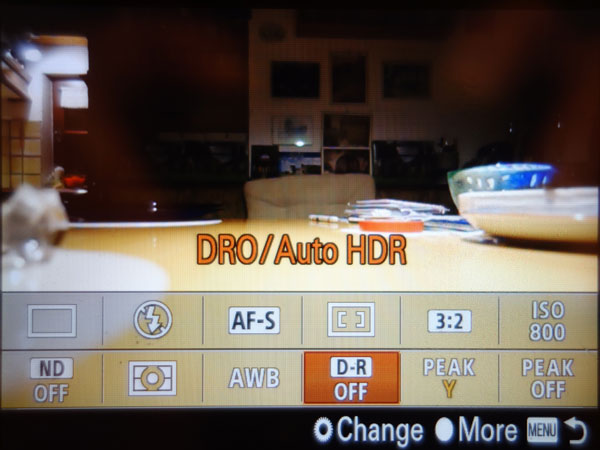 |
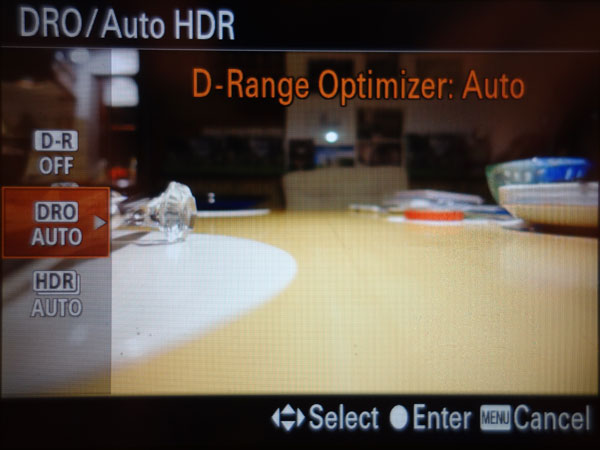 |
|
Fn button menu, DRO/HDR Auto selected |
The DRO/HDR Auto settings |
Differently from the RX100 M1, the Fn buttons enters and exits the menu. The four control wheel buttons move you through the menu table, and the control wheel itself (or the control ring) is used to select options. You can also press the center button to enter a selection screen with its own rules as shown in the right figure above. Sony engineers...
Above, I listed my "personal" assignment of functions to the Fn button menu slots. Here they are again:
- Drive Mode
- Flash Mode
- Focus Mode
- Focus Area
- Aspect Ratio
- ISO
- ND Filter
- Metering Mode
- White Balance
- DRO/Auto HDR
- Peaking Color
- Peaking Level
This is the current state, and it will take some time before I really know, which functions I use often and should therefore be added to the Fn button menu. And the positions are also preliminary (and inspired by the original state of the menu).
Configuration of the Control Ring
Usually, the control ring is set to Standard and performs one function that is specific to the selected shooting mode (e.g. P: program shift, A: aperture, S: shutter speed). I set the control ring, however, to Zoom to utilize the Step Zoom feature, because I like to use "default" focal lengths (24, 28, 35, 50, 70 mm), and there are also some additional benefits to this. This requires some additional settings to be made, which are described on the page about zoom modes and repeated here:
First, you have to enable zooming with the control ring (Custom menu, page 5, Custom Key Settings > set Control Ring to Zoom):
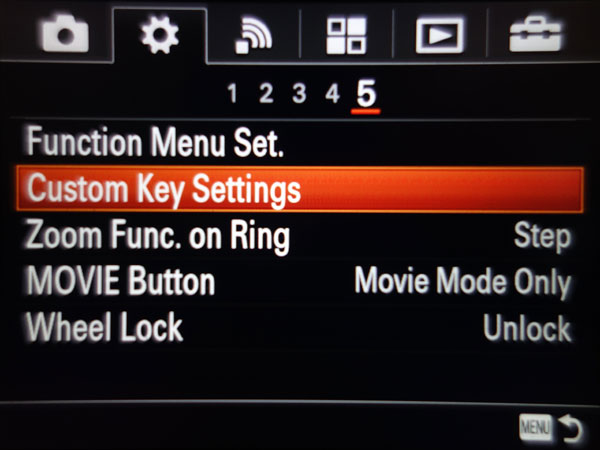 |
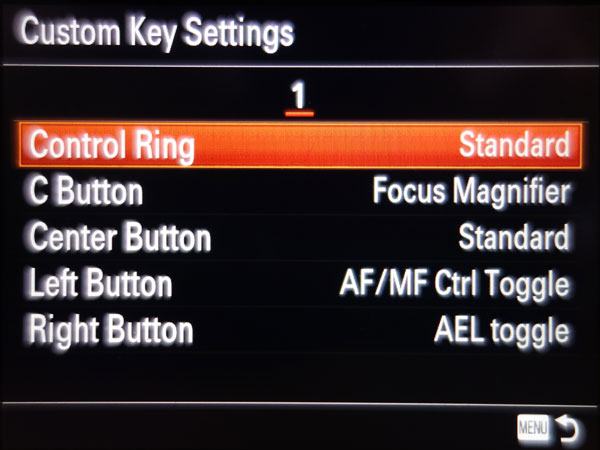 |
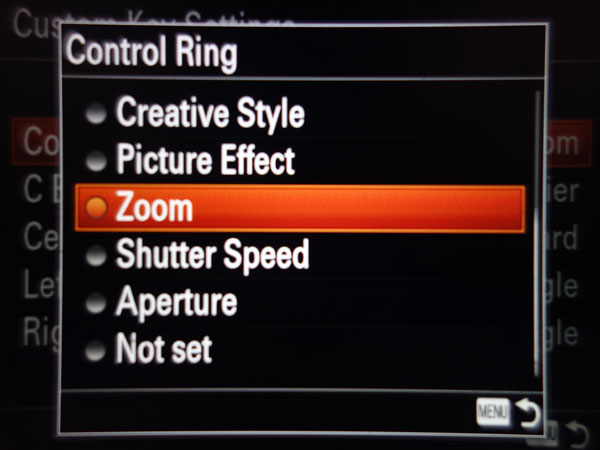 |
||
The Custom Key Settings menu item in the Custom menu (page 5) allows you to select Zoom as operation for the control ring (default: Standard) |
Control Ring selected (page 1) ... |
... and set to Zoom |
Secondly, in the Custom menu, page 5, you can enable or disable the Step Zoom feature:
Further Useful Settings
In addition to the settings of the buttons and rings there are some further settings, which determine the behavior of the camera and are quite useful for me. Some of them can be done by assigning a function to a buttons or to the Fn menu, others only by going into the menu system. In the following, I provide a table of those settings that I find important for me; they all reside in the Custom menu (see the screens in the appendix).
| Name | Page | My Value | Comment |
| MF Assist | 1 | On | Magnifies as soon as you turn the focus ring; I find this helpful most of the time |
| Focus Magnif. Time | 1 | No Limit | A matter of taste... |
| Grid Line | 1 | Rule of 3rds Grid | Helps me aligning objects |
| Auto Review | 2 | 5 sec | Maybe, I will extend this time |
| Peaking Level | 2 | Mid | As a start... |
| Peaking Color | 2 | Yellow | As a start... |
| Live View Display | 2 | Setting Effect On | Shows the correct exposure immediately |
| Pre AF | 3 | On | I set this to "On" for all our cameras (it is permanently "On" at the RX100 M1) |
| Zoom Setting | 3 | Optical Zoom Only | I may change this for bugs and butterflies... |
Conclusions
The Sony RX100 M4 looks like a highly customizable camera. At a closer look, however, I felt more constrained than with, for example, our Ricoh cameras. The options look fairly complex at first sight, and the minor differences between some options make the configuration process also somewhat confusing. Nevertheless, I found out that it is possible to overcome some limitations of the camera by using its configuration options, which is good news, after all. On the RX100 M4, there is one more configurable button available than on the RX100 M1, namely the C (custom) button. This seemingly small difference makes indeed things a lot easier on this camera, compared with the RX100 M1.
Links and Books
- Alexander S. White (2015). Photographer’s Guide to the Sony DSC-RX100 IV. White Knight Press, Henrico, Virginia (ISBN: 978-1937986476, paperback)
- Michael Gradias (2015). Sony RX100 IV. Markt+Technik Verlag, Burgthann (ISBN: 978-3-95982-326-5, paperback and PDF) (German)
- Tips and tricks for the Sony RX100 IV (Wim Ary, Wim Ary's Photography): www.wimarys.com/tips-tricks-sony-rx100-iv/
Appendix: A Demonstration of the Settings Screens
In the following, I show the settings screens that you will find in the camera's Custom menu:
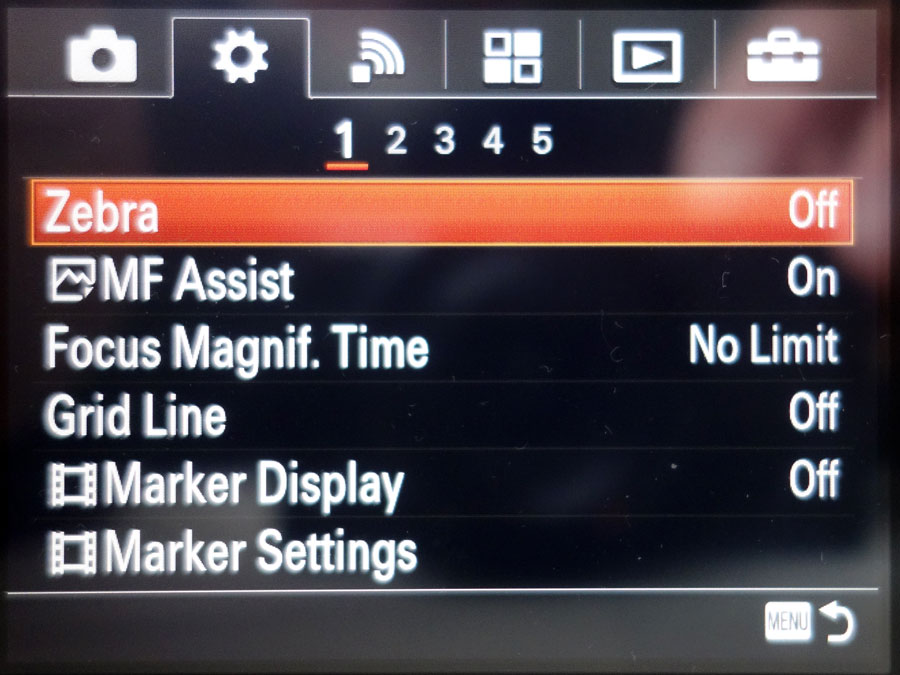 |
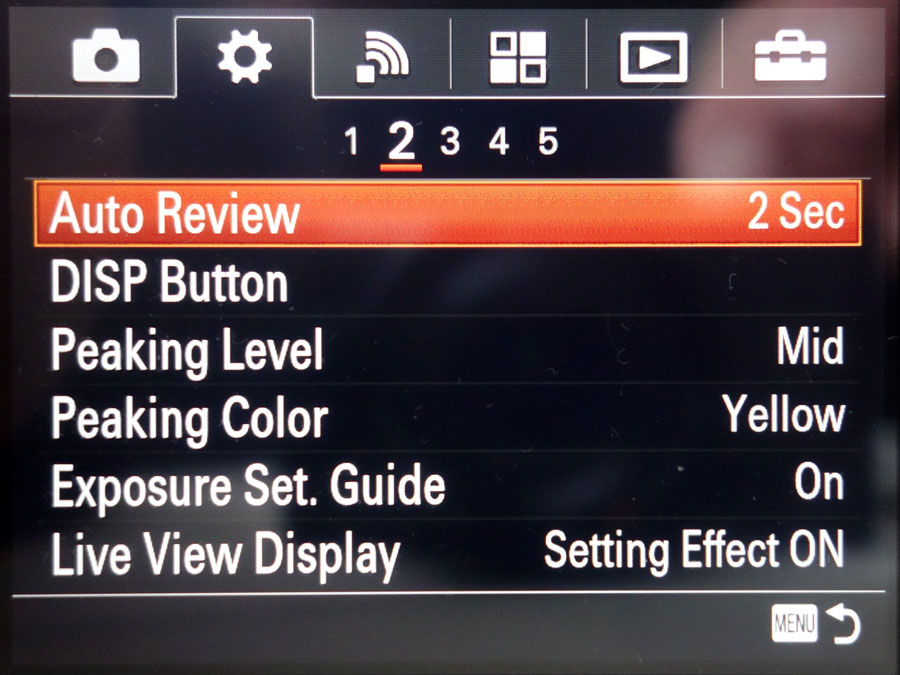 |
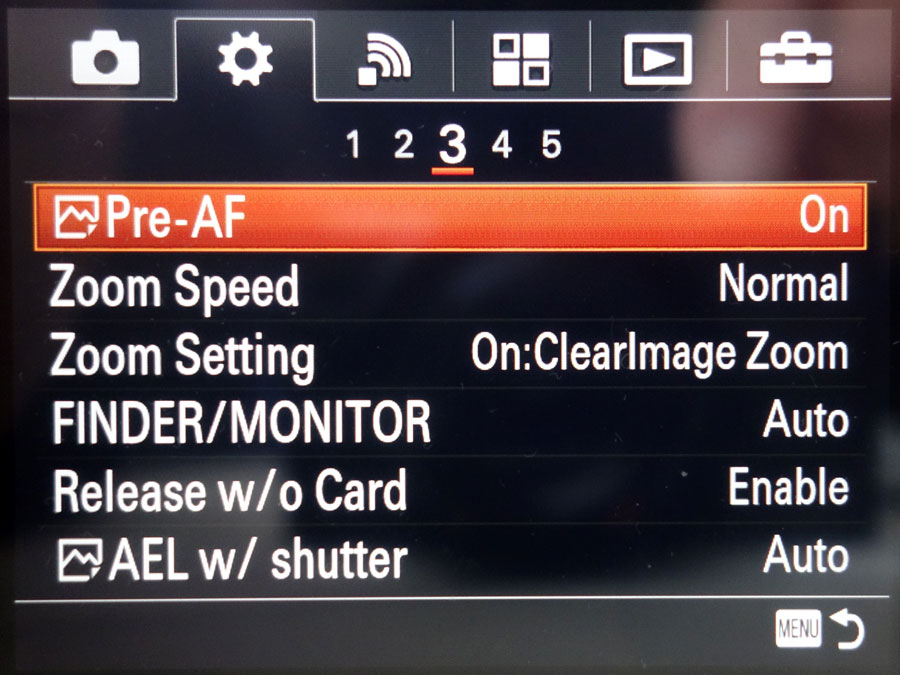 |
||
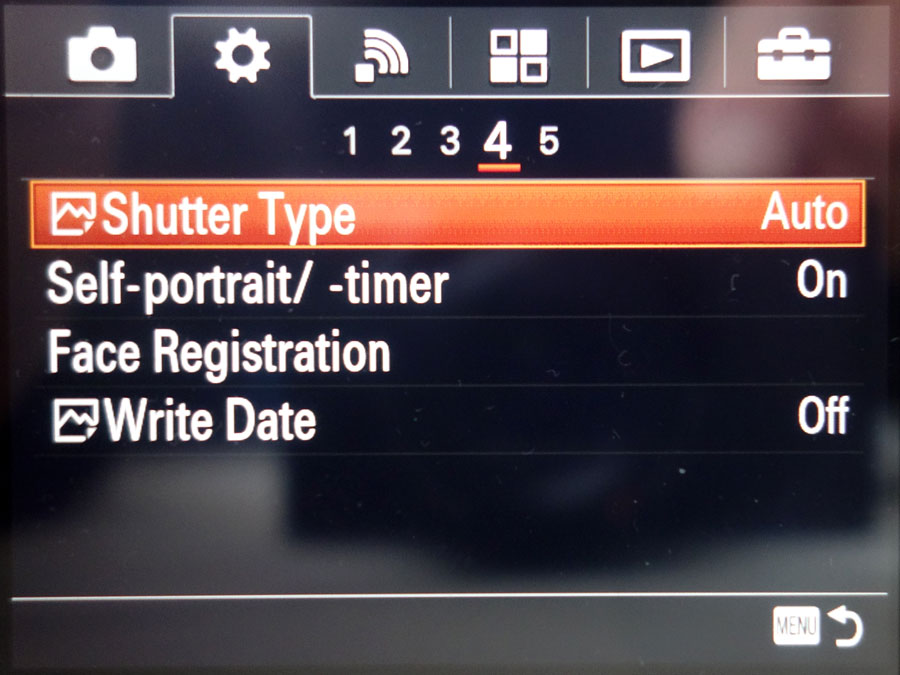 |
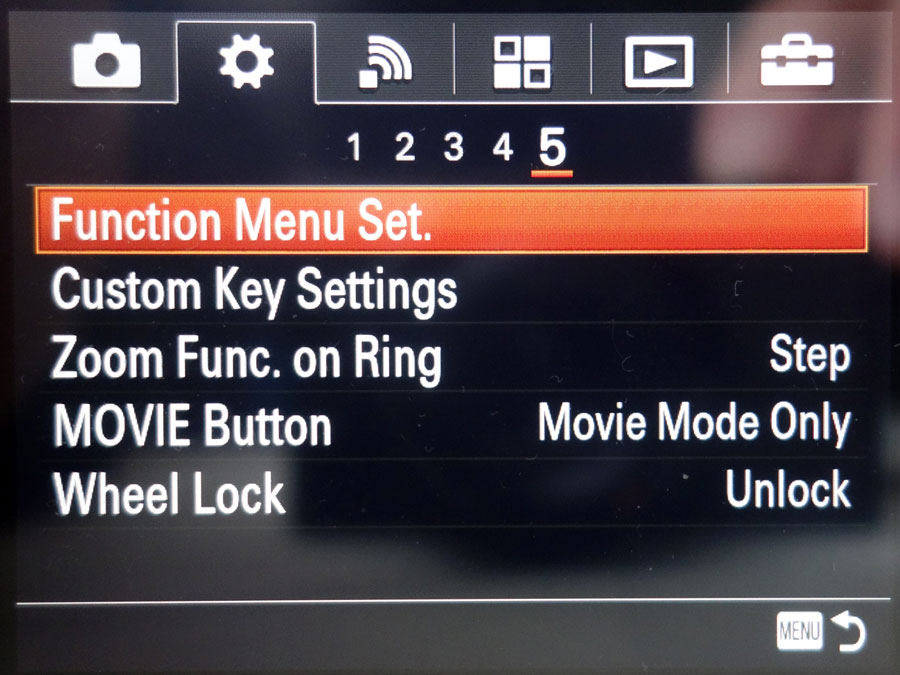 |
Note that on screen 5 you can see the assignments that I describe above (left, center, and right button on the control wheel, custom button, Fn menu button, control ring) Many of the menu items have sub-menus (and these may also have sub-menus...). |
Note that the settings shown may or may not correspond to my own choices (most of them do, but currently I use a 3 x 3 grid)...
| 10.05.2023 |
